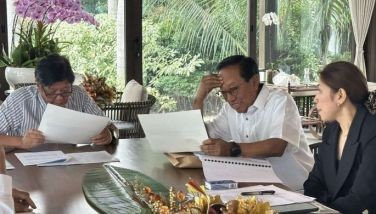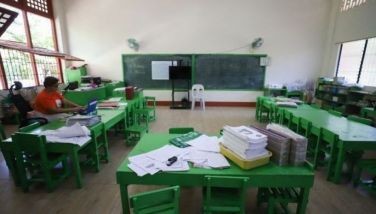YEARENDER: International disaster deals signed amid high number of Pinoy casualties
MANILA, Philippines - The year 2015 proved to be a historic one for countries prone to natural disasters like the Philippines.
Three international agreements related to disasters were crafted this year, a development that Philippine officials believe reflected the growing awareness about the need for more resilient communities and economies.
The Sendai Framework, which recognizes the role of the state and other stakeholders in reducing disaster risk, was adopted last March. The Asia-Pacific Economic Cooperation (APEC) Disaster Risk Reduction Framework, meanwhile, was approved in Iloilo City in September.
A long-awaited climate agreement was also adopted in Paris in December, but not without protests by some groups who believe that poor countries were shortchanged during the negotiations.
“The year 2015 was a year of both challenges and opportunities,” National Disaster Risk Reduction and Management Council (NDRRMC) executive director Alexander Pama told The STAR in an interview.
“It was a year of challenges as we have seen and experienced the effects of strong typhoons… It was also a year of opportunity because respected groups like the UNISDR (United Nations Office for Disaster Risk Reduction) and other counties said we are doing what is right,” he added.
Pama claimed that the Philippines, a country visited by about 20 typhoons every year, played a key role in the adoption of all three agreements.
With regard to the Sendai Framework, a 15-year non-binding agreement that aims to substantially reduce disaster-related deaths and losses, Pama said the Philippines pushed for gender sensitivity and the participation of migrant workers.
He said the country also lobbied for the inclusion of pre-disaster risk assessment, a concept now embodied in paragraph 23 of the agreement.
“We contributed important aspects to the Sendai Framework, particularly in pre-disaster risk assessment and understanding disasters,” Pama said.
“It was a very significant milestone in terms of disaster risk reduction and we played a very significant role in the passage of that framework,” he said.
The framework has seven global targets: to substantially reduce global disaster mortality, reduce the number of affected people globally, reduce direct disaster economic loss, substantially reduce disaster damage to critical infrastructure and disruption of basic services, substantially enhance international cooperation to developing countries through adequate and sustainable support, substantially increase the availability of and access to early warning systems and disaster risk information and assessments all by 2030, and substantially increase the number of countries with national and local disaster risk reduction strategies by 2020.
To achieve these goals, countries need to undertake four priorities of action, namely to understand disaster risk, strengthen disaster risk governance, invest in disaster risk reduction and enhance disaster preparedness for effective response and rehabilitation.
Non-binding
The APEC Disaster Risk Reduction Framework, meanwhile, was described by Pama as a document “practically authored by the Philippines.”
“For the first time in the history of APEC, it now has disaster risk reduction framework,” Pama said.
The document, however, is also non-binding and there have been doubts as to whether it could really promote international cooperation on disaster response. Pama, however, believes that the adoption of the framework is in itself an important development.
“It may not be binding but we now have a basis and framework for the conduct of activities related to emergency preparedness,” he said.
Pama stressed that the “new normal” – a term used to describe unpredictable and increasing frequency and magnitude of disasters – requires stronger cooperation among APEC member-economies.
The framework, the first document on disaster preparedness adopted by APEC since the economic bloc was formed in 1989, emphasizes the importance of prevention and mitigation, preparedness and response, recovery and rehabilitation.
It also acknowledges the role of the private sector in promoting disaster resilience and sustainable development. APEC member-economies have also agreed to craft an action plan to implement, monitor and evaluate activities related to the framework.
Controversial climate deal
The 21st Conference of Parties to the United Nations Framework Convention on Climate Change (UNFCCC) drew mixed reviews. While delegates were able to prove wrong the doomsayers who predicted that nothing significant would come out of the event, some critics are not satisfied with the outcome, which has been criticized as vague on key issues including climate finance.
Under the agreement, countries will work to hold global warming “well below” two degrees Celsius and to pursue efforts to limit the temperature increase to 1.5 degrees Celsius above pre-industrial levels.
The Philippines and other vulnerable countries pushed for the lowering of the UNFCCC’s temperature goal to 1.5 degrees Celsius from 2 degrees, saying this would ensure their survival.
Parties will also stop the increase in greenhouse gas emissions, which has been linked to global warming. The agreement, however, is silent on countries that failed to meet their emission reduction goals.
Some groups also claimed that the agreement did not have enough provisions on climate financing for countries vulnerable to climate change.
Rodne Galicha, Philippine manager of The Climate Reality Project, said while the agreement may become “a spark of hope to save the planet,” it did not have much to say about loss and damage mechanisms.
“Ambitious it may seem, there is still a great imbalance – no clear finance mechanism for loss and damage. This agreement is useless if countries are unable to ratify and implement – the challenge lies on governments and their people,” Galicha said in a recent statement.
“Historical responsibility, liability and compensation are not addressed, hence, most vulnerable countries which experienced massive losses and damage may be at the crossroads,” he added.
International humanitarian group Oxfam, meanwhile, said the deal is “a landmark step” but “has not done enough to ensure that a three degrees Celsius world will be avoided or secure sufficient climate funding for vulnerable communities.
“The Paris climate deal has brought the world’s powers together but has shortchanged the poorest and most vulnerable people as they struggle with the burgeoning reality of rising sea-levels, floods and drought Oxfam warned today,” Oxfam said in a statement.
The group said the ambitious speeches from world leaders opening the summit were not sustained until the end of the talks.
“This deal offers a frayed lifeline to the world’s poorest and most vulnerable people. Only the vague promise of a new future climate funding target has been made, while the deal does not force countries to cut emissions fast enough to forestall a climate change catastrophe. This will only ramp up adaptation costs further in the future,” Oxfam executive director Helen Szoke said.
“Governments across the world have now come together in the global fight against climate change but must play catch up. We will be holding them to account with the millions of people who marched in cities all around the world so that dangerous warming is averted and the world’s poorest and most vulnerable communities get the support that they need,” she added.
Oxfam said there is nothing in the agreement that guarantees that current commitments of countries will improve before they come into force, making it hard to reach the two degrees Celsius goal and almost impossible to avoid warming of more than 1.5 degrees Celsius that developing countries, including the Philippines, believe is necessary for their survival.
Pama, however, believes that all the climate concerns cannot be resolved by a single agreement.
“We cannot expect to come up with a perfect document in a span of two weeks. The fact that there is already a document, that there is an agreement in principle in most of the areas, that is already a major movement,” Pama said.
“It is understandable that some countries will push for their respective interests. Some will say it’s for the survival of some countries, others will say hey, if you ban the use of oil, it will also affect our survival,” he added.
“I won’t complain about the agreement but it could have been better.”
Impact of typhoons
While the government claimed to have several achievements in disaster management, the number of casualties and amount of damage caused by typhoons that hit the country this year remained high.
A total of 116 people died while 35 others went missing in 13 typhoons that visited the country this year. The typhoons also left 133 persons injured, data from the NDRRMC showed.
The typhoons also affected 4.2 million persons or more than 976,000 families and damaged P18.24 billion worth of properties.
- Latest
- Trending































